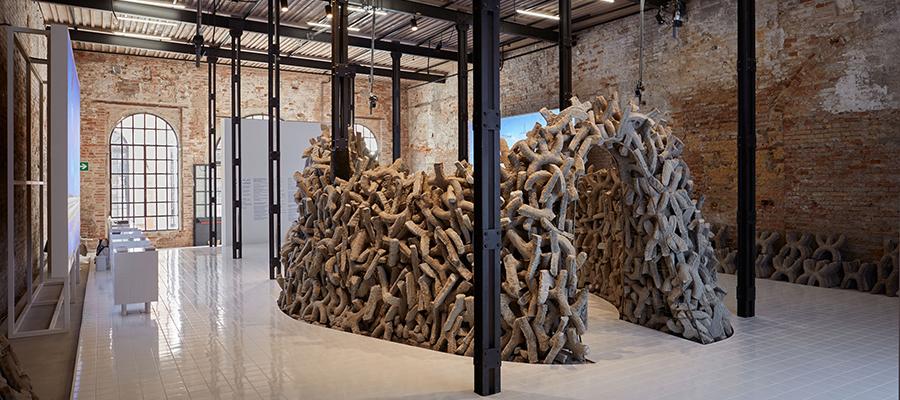- About
- Admissions
- Study at AUS
- Prospective Students
- Bachelor's Degrees
- Master's Degrees
- Doctoral Degrees
- Admission Publications
- International Students
- Contact Admissions
- Grants and Scholarships
- Sponsorship Liaison Services
- Testing Center
- New Student Guide
- File Completion
- New Student Orientation
- Payment Guide
- Executive Education
- Students with Disabilities
- Academics
- Life at AUS
- Research
- Contact Us
- Apply Now
- .

AUS designers, scientists present sustainable cement alternative at Venice Biennale
A team of faculty and alumni from American University of Sharjah (AUS) have contributed to significant research into an innovative sustainable cement alternative, presented in the National Pavilion UAE’s (NPUAE) featured exhibition Wetland at the Venice Architecture Biennale.
The NPUAE was awarded highest honors with a Golden Lion Award for Best National Participation in the 17th International Architecture Exhibition, hailed as “a bold experiment that encourages us to think about the relationship between waste and production on a local and global scale, and opens us to new construction possibilities between craft and high-technology.”
The acclaimed pavilion curators Wael Al Awar and Kenichi Teramoto were chosen in 2019 by a selection committee that included AUS Professor of Architecture Kevin Mitchell while he was serving as the university’s Chancellor. The pavilion centers around a prototype handmade from recycled industrial waste brine and inspired by the UAE’s traditional coral-built houses.
The research was conducted by faculty and alumni of AUS’s College of Architecture, Art and Design (CAAD) and College of Arts and Sciences (CAS), who collaborated with specialist teams from the New York University Abu Dhabi’s Amber Lab, and the University of Tokyo’s Obuchi Lab and Sato Lab. The researchers propose salt and minerals found in the UAE’s sabkha heritage sites could provide a more sustainable and environmentally friendly alternative to cement for construction in the region.
Under the supervision of Associate Professor of Chemistry Dr. Lucia Pappalardo, AUS alumna Aysha Shabnam contributed to the development of the chemical formula for this new material known as magnesium oxide cement (MgO).
“This project provided us with an opportunity to contribute to a sustainable alternative for Portland cement. We worked on the design and development of a material that is stable, sustainable, withstands significant pressure and easy to produce with available local products. I am grateful to have collaborated with AUS and NPUAE for this project and hope it reaches many heights,'' Shabnam said.
Designers then used advanced digital engineering technology to create a 7 x 5-meter prototype constructed out of hand-cast shapes. The design research team included CAAD alumni Lujaine Rizk, Aisha Al Sahlawi, Dina Al Khatib, Ibrahim Khamis, Adomas Zeineldin and Ibrahim Ibrahim.
"The success of the Wetland project highlights the importance of bringing together global multidisciplinary expertise to advance the field of architecture. Our team of architects, engineers, chemists and scientists experimented with a revolutionary construction material called MgO, which has the potential to transform the construction industry by dramatically reducing its carbon footprint and waste production,” said Rizk.
“As the team's Lab and Research Coordinator, my role involved producing multiple experimental and full-scale prototypes over a period of two years resulting in the final installation. I also managed the production team on-site in Venice as they built the final installation. In addition, I managed our lab/exhibition space in Alserkal Avenue where I gave tours and workshops to our visitors," she said.
Beyond the Wetland exhibition, visiting CAAD faculty member Dalia Hamati coordinated and moderated an international open call titled “A Bench in Venice” that ran over the summer as part of the NPUAE’s contribution to the Venice Biennale Curators Collective. Among the seven entries contributed by the UAE are works by three current AUS students—Amal Saleh, Janet Jacob and Muhammad Faruqi—who now have their work installed in the NPUAE space in Venice.
George Katodrytis, Head of the Department of Architecture at CAAD, said opportunities to participate in global competitions like this are an important part of the CAAD student experience.
“It’s a great honor for our alumni who receive this international exposure. At the same time it is also incredibly inspiring for other CAAD students as they see their peers represented on the global stage,” he said.
“In addition, CAAD has always been well represented among the NPUAE internship program over the past ten years, which is an excellent opportunity for students to get involved in other aspects of the design industry such as cultural diplomacy, curating and more,” he said.
The National Pavilion will be open to the public in Venice until November 21, 2021. For a virtual tour, visit www.nationalpavilionuae.org or go to https://curatorscollective.org/opencall-submissions-7/#uae to view the student’s work online.
For more information about American University of Sharjah, visit www.aus.edu.
Photo caption: Image courtesy National Pavilion UAE La Biennale di Venezia. Photography by Frederico Torra for PLANE-SITE

